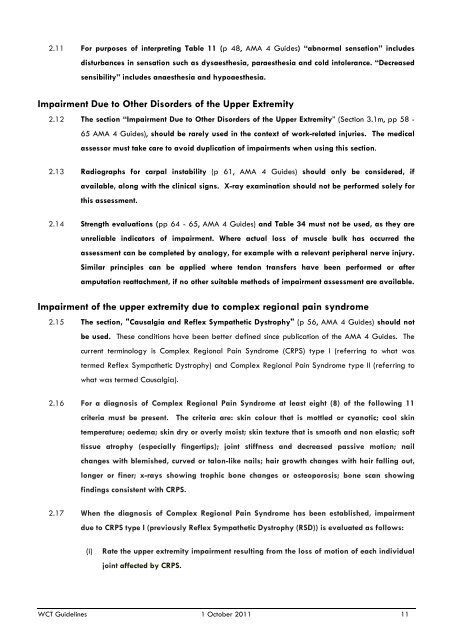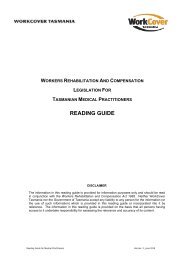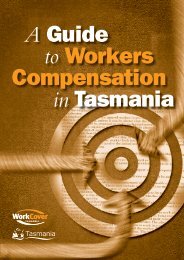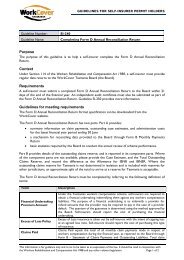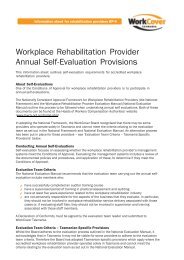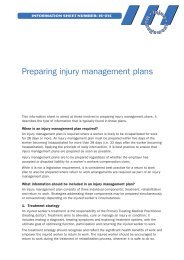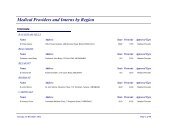Guidelines for the assessment of permanent impairment Version 3
Guidelines for the assessment of permanent impairment Version 3
Guidelines for the assessment of permanent impairment Version 3
You also want an ePaper? Increase the reach of your titles
YUMPU automatically turns print PDFs into web optimized ePapers that Google loves.
2.11 For purposes <strong>of</strong> interpreting Table 11 (p 48, AMA 4 Guides) “abnormal sensation” includesdisturbances in sensation such as dysaes<strong>the</strong>sia, paraes<strong>the</strong>sia and cold intolerance. “Decreasedsensibility” includes anaes<strong>the</strong>sia and hypoaes<strong>the</strong>sia.Impairment Due to O<strong>the</strong>r Disorders <strong>of</strong> <strong>the</strong> Upper Extremity2.12 The section “Impairment Due to O<strong>the</strong>r Disorders <strong>of</strong> <strong>the</strong> Upper Extremity” (Section 3.1m, pp 58 -65 AMA 4 Guides), should be rarely used in <strong>the</strong> context <strong>of</strong> work-related injuries. The medicalassessor must take care to avoid duplication <strong>of</strong> <strong>impairment</strong>s when using this section.2.13 Radiographs <strong>for</strong> carpal instability (p 61, AMA 4 Guides) should only be considered, ifavailable, along with <strong>the</strong> clinical signs. X-ray examination should not be per<strong>for</strong>med solely <strong>for</strong>this <strong>assessment</strong>.2.14 Strength evaluations (pp 64 - 65, AMA 4 Guides) and Table 34 must not be used, as <strong>the</strong>y areunreliable indicators <strong>of</strong> <strong>impairment</strong>. Where actual loss <strong>of</strong> muscle bulk has occurred <strong>the</strong><strong>assessment</strong> can be completed by analogy, <strong>for</strong> example with a relevant peripheral nerve injury.Similar principles can be applied where tendon transfers have been per<strong>for</strong>med or afteramputation reattachment, if no o<strong>the</strong>r suitable methods <strong>of</strong> <strong>impairment</strong> <strong>assessment</strong> are available.Impairment <strong>of</strong> <strong>the</strong> upper extremity due to complex regional pain syndrome2.15 The section, "Causalgia and Reflex Sympa<strong>the</strong>tic Dystrophy" (p 56, AMA 4 Guides) should notbe used. These conditions have been better defined since publication <strong>of</strong> <strong>the</strong> AMA 4 Guides. Thecurrent terminology is Complex Regional Pain Syndrome (CRPS) type I (referring to what wastermed Reflex Sympa<strong>the</strong>tic Dystrophy) and Complex Regional Pain Syndrome type II (referring towhat was termed Causalgia).2.16 For a diagnosis <strong>of</strong> Complex Regional Pain Syndrome at least eight (8) <strong>of</strong> <strong>the</strong> following 11criteria must be present. The criteria are: skin colour that is mottled or cyanotic; cool skintemperature; oedema; skin dry or overly moist; skin texture that is smooth and non elastic; s<strong>of</strong>ttissue atrophy (especially fingertips); joint stiffness and decreased passive motion; nailchanges with blemished, curved or talon-like nails; hair growth changes with hair falling out,longer or finer; x-rays showing trophic bone changes or osteoporosis; bone scan showingfindings consistent with CRPS.2.17 When <strong>the</strong> diagnosis <strong>of</strong> Complex Regional Pain Syndrome has been established, <strong>impairment</strong>due to CRPS type I (previously Reflex Sympa<strong>the</strong>tic Dystrophy (RSD)) is evaluated as follows:(i)Rate <strong>the</strong> upper extremity <strong>impairment</strong> resulting from <strong>the</strong> loss <strong>of</strong> motion <strong>of</strong> each individualjoint affected by CRPS.WCT <strong>Guidelines</strong> 1 October 2011 11


